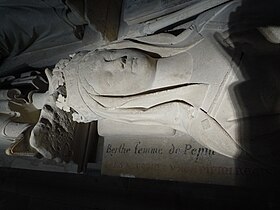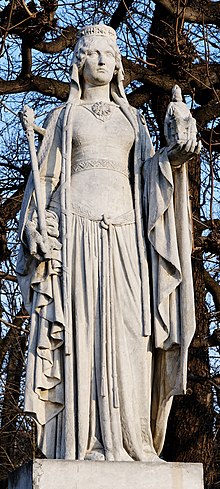Bertrada of Laon
Bertrada of Laon | |
|---|---|
 Tomb of Bertrada of Laon at the Saint Denis Basilica | |
| Born | between 710 and 727 |
| Died | 12 July 783 Choisy-au-Bac |
| Buried | Saint Denis Basilica |
| Spouse(s) | Pepin the Short |
| Father | Charibert of Laon |
| Mother | Gisele of Aquitaine |
Bertrada of Laon (born between 710 and 727 – 12 July 783), also known as Bertrada the Younger or Bertha Broadfoot (cf. Latin: Regina pede aucae i.e. the queen with the goose-foot), was a Frankish queen. She was the wife of Pepin the Short and the mother of Charlemagne, Carloman and Gisela.
Nickname
Bertrada's nickname "Bertha Broadfoot" dates back to the 13th century, when it was used in Adenes Le Roi's trouvère Li rouman de Berte aus grands piés.[1] The exact reason that Bertrada was given this nickname is unclear. It is possible that Bertrada was born with a clubfoot,[2] although Adenes does not mention this in his poem.[1] The nickname might have been a reference to an ancient legend about a Germanic goddess named Perchta, to real and mythological queens named Bertha, or to several similarly-named Christian queens.[3] Many myths and legends exist in Europe and Asia, in which clubfooted people are described as the link between the world of the living and the spirit world.[4]
Biography
Early life and ancestry
Bertrada was born sometime between 710 and 727 in Laon, in today's Aisne, France, to Count Charibert of Laon[5] and Gisele of Aquitaine.[citation needed] Charibert's father might have been related to Hugobertides.[6][7] Charibert's mother was Bertrada of Prüm, who founded Prüm Abbey along with Charibert. Bertrada of Prüm was possibly the daughter of Theuderic III.[5]
-
Bertrada Broadfoot of Laon
-
Bertrada of Laon
Marriage and children
Bertrada married Pepin the Short, the son of Charles Martel, the Frankish "Mayor of the Palace", in 741. However, Pepin and Bertrada were too closely related for their marriage to be legal at that time; the union was not canonically sanctioned until 749, after the birth of Charlemagne.[8]
According to French historian Léon Levillain, Bertrada was Pepin's first and only wife.[9][10][11] Other sources suggest that Pepin had previously married a "Leutberga" or "Leutbergie", with whom Pepin would have had five children.[12]
Bertrada and Pepin are known to have had seven children: three sons and four daughters. Of these, Charlemagne (c. 742 – 814),[13] Carloman (751 – 771)[14] and Gisela (757 – 811) survived to adulthood. Pepin, born in 756, died in his infancy in 762. Bertrada and Pepin also had Berthe, Adelaide, and Rothaide. Gisela became a nun at Chelles Abbey.[15]
Pepin tried to divorce Bertrada a few years after their marriage, but the Pope opposed the divorce.[16] The reason is still unknown, but according to historian Christian Settipani, Pepin might have wanted to marry a woman named Angla, who was the daughter of Theodrade.[14]
Queen of the Franks

In 751, Pepin and Bertrada became King and Queen of the Franks, following Pepin's successful coup against the Frankish Merovingian monarchs.[17] Pepin was crowned in June 754, and Bertrada, Charlemagne, and Carloman were blessed by Pope Stephen II.[18][19]
After Pepin's death in 768, Bertrada lost her title as Queen of the Franks. Charlemagne and Carloman inherited the two halves of Pepin's kingdom. Bertrada stayed at the court and often tried to stop arguments between the two brothers.[14] Some historians credit Bertrada's support for her elder son Charlemagne over her younger son Carloman, and her diplomatic skills, for Charlemagne's early success.[20] Although her influence over Charlemagne may have diminished in time, she lived at his court, and, according to Einhard, their relationship was excellent. Bertrada recommended that Charlemagne set aside his legal wife, Himiltrude, and marry Desiderata, a daughter of the Lombard king Desiderius, but Charlemagne soon divorced Desiderata. Einhard claims this was the only episode that ever strained relations between mother and son.[14]
Later life and death
Bertrada retired from the court after Carloman's death in 771 to live in Choisy-au-Bac, where Charlemagne had set aside a royal house for her. Choisy-au-Bac was favorable because of its history of being the home and burial place of several Merovingian kings.[14]
Bertrada died on 12 July 783 in Choisy-au-Bac.[14] Charlemagne buried her in the Basilica of St Denis near Pepin.[21]
In literature
Bertrada inspired Adenes Le Roi to write the trouvère Li rouman de Berte aus grands piés in 1270. Adenes referred to her as "Bertha Broadfoot", the earliest known usage of that nickname.[1]
Bertrada is also referred to as "Bertha Broadfoot" in François Villon's 15th-century poem Ballade des dames du temps jadis.[22]
Notes
- ^ a b c Scheler & Le Roi 1874.
- ^ Pelletier 2014, p. 52.
- ^ Grimm 1835, p. 8.
- ^ Ginzburg & Aymard 1989, pp. 206–251.
- ^ a b Settipani 1989.
- ^ Keats-Rohan & Settipani 2000, p. 18.
- ^ Pinoteau & de Vaulchier 2004, p. 43.
- ^ Kurze 1895, p. 8.
- ^ Tessier 1952.
- ^ Settipani & van Kerrebrouck 1993, pp. 180–187.
- ^ Levillain 1944, p. 55.
- ^ Ducret 2007.
- ^ Settipani & van Kerrebrouck 1993, p. 188.
- ^ a b c d e f Settipani & van Kerrebrouck 1993, p. 185.
- ^ Settipani & van Kerrebrouck 1993, pp. 185–187.
- ^ Bibliothèque de l'École des chartes 1943, p. 59.
- ^ Mémoires couronnés et autres mémoires publiés par l'Académie royale des sciences, des lettres et des beaux-arts de Belgique 1861, p. 97.
- ^ Settipani & van Kerrebrouck 1993, p. 184.
- ^ Bernard 2004, p. 91.
- ^ Lewis 2008.
- ^ Les gisants de la basilique de Saint-Denis 2014.
- ^ Villon c. 1460.
References
- Les gisants de la basilique de Saint-Denis (Map). 1 : 10 m (in French). Saint-Denis, France. 2014. Retrieved 29 April 2014.
{{cite map}}: Unknown parameter|trans_title=ignored (|trans-title=suggested) (help) - Mémoires couronnés et autres mémoires publiés par l'Académie royale des sciences, des lettres et des beaux-arts de Belgique (in French). Vol. 11. Belgium: Royal Academies for Science and the Arts of Belgium. 1861. OCLC 1770765.
{{cite book}}: Unknown parameter|trans_title=ignored (|trans-title=suggested) (help) - "Bibliothèque de l'École des chartes" (in French). 104. Paris, France: Librairie Droz. 1943. ISSN 0373-6237. OCLC 1532871.
{{cite journal}}: Cite journal requires|journal=(help); Unknown parameter|trans_title=ignored (|trans-title=suggested) (help) - Bernard, Guillaume (2004). Introduction à l'histoire du droit et des institutions. Panorama du droit. Premier cycle. (in French). Levallois-Perret: Studyrama. ISBN 2844724426. OCLC 419527703.
{{cite book}}: Invalid|ref=harv(help); Unknown parameter|trans_title=ignored (|trans-title=suggested) (help) - Ducret, Alix (2007). Les femmes et le pouvoir dans l'histoire de France. Perspectives (in French). Levallois-Perret: Studyrama. ISBN 2759001113. OCLC 421956409.
{{cite book}}: Invalid|ref=harv(help); Unknown parameter|trans_title=ignored (|trans-title=suggested) (help) - Ginzburg, Carl; Aymard, Monique (1989). Mythes, emblèmes, traces ; morphologie et histoire (in French). Paris, France: Flammarion. ISBN 2082111849. OCLC 19925431.
{{cite book}}: Invalid|ref=harv(help); Unknown parameter|trans_title=ignored (|trans-title=suggested) (help) - Grimm, Jacob (1835). "Deutsche Mythologie". New Northvegr Center (in German). Transcribed by Aaron Myer. Northvegr. ch. 13.
{{cite web}}: Invalid|ref=harv(help); Unknown parameter|trans_title=ignored (|trans-title=suggested) (help) - Keats-Rohan, Katharine Stephanie Benedicta; Settipani, Christian (2000). Onomastique et Parenté dans l'Occident médiéval (in French). Oxford, UK: Linacre College. ISBN 1900934019. OCLC 492431344.
{{cite book}}:|work=ignored (help); Invalid|ref=harv(help); Unknown parameter|trans_title=ignored (|trans-title=suggested) (help) - Kurze, Friedrich (1895). Scriptores rerum Germanicarum in usum scholarum separatim editi 6: Annales regni Francorum inde ab a. 741 usque ad a. 829, qui dicuntur Annales Laurissenses maiores et Einhardi (in Latin). Hannover: Hannoverian Library.
{{cite book}}: Invalid|ref=harv(help); Unknown parameter|trans_title=ignored (|trans-title=suggested) (help) - Levillain, Léon (1944). "La charte de Clotilde (10 mars 673)". Études mérovingiennes (in French). 105 (105). Bibliothèque de l'école des chartes: 5–63. doi:10.3406/bec.1944.449321. Retrieved 28 April 2014.
{{cite journal}}: Invalid|ref=harv(help); Unknown parameter|trans_title=ignored (|trans-title=suggested) (help) - Lewis, David Levering (2008). God's Crucible: Islam and the Making of Europe, 570 to 1215. New York: W.W. Norton. ISBN 9780393064728. OCLC 172521784.
{{cite book}}: Invalid|ref=harv(help) - Pelletier, Michel (2014). Quelques femmes remarquables dans l'histoire du département de l'Aisne (PDF) (in French). pp. 52–64.
{{cite book}}: Invalid|ref=harv(help); Unknown parameter|trans_title=ignored (|trans-title=suggested) (help) - Pinoteau, Hervé; de Vaulchier, Jean (2004). La symbolique royale française, Ve - XVIIIe siècles (in French). La Roche-Rigault, France: PSR. ISBN 2908571366. OCLC 55051298.
{{cite book}}: Invalid|ref=harv(help); Unknown parameter|trans_title=ignored (|trans-title=suggested) (help) - Scheler, Auguste; Le Roi, Adenet (1874). Li roumans de Berte aus grans piés par Adenés li Rois; poëme publié, d'après le manuscrit de la bibliothèque de l'Arsenal, avec notes et variantes (in French). Brussels, Belgium: Académie royale de Belgique. OCLC 465546842.
{{cite book}}: Invalid|ref=harv(help); Unknown parameter|trans_title=ignored (|trans-title=suggested) (help) - Settipani, Christian (1989). Les Ancêtres de Charlemagne (in French). Paris, France. ISBN 2-906483-28-1. OCLC 28323789.
{{cite book}}: Invalid|ref=harv(help); Unknown parameter|trans_title=ignored (|trans-title=suggested) (help)CS1 maint: location missing publisher (link) - Settipani, Christian; van Kerrebrouck, Patrick (1993). "Première partie : Mérovingiens, Carolingiens et Robertiens". La préhistoire des Capétiens (481-987) (in French). Vol. 1. ISBN 2-9501509-3-4. OCLC 29856008.
{{cite book}}:|work=ignored (help); Invalid|ref=harv(help); Unknown parameter|trans_chapter=ignored (|trans-chapter=suggested) (help); Unknown parameter|trans_title=ignored (|trans-title=suggested) (help) - Tessier, Georges (1952). "Nécrologie". Chronique (in French). 110 (110). Bibliothèque de l'école des chartes: 306–313. Retrieved 28 April 2014.
{{cite journal}}:|chapter=ignored (help); Invalid|ref=harv(help); Unknown parameter|trans_title=ignored (|trans-title=suggested) (help) - Villon, François (c. 1460). Ballade des dames du temps jadis (in French). France.
{{cite book}}: Invalid|ref=harv(help)


